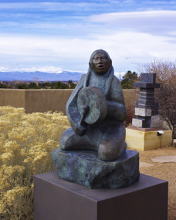Article
Founded in 1937 by Mary Cabot Wheelwright, a wealthy Bostonian, in collaboration with Hosteen Klah, a Navajo singer or hataalii, the museum's purpose was to preserve Navajo religion, oral tradition, and culture. It was called the Navajo House of Prayer and House of Navajo religion before being named the Museum of Navajo Ceremonial Art prior to its public opening.
Due to several factors, including the Navajo Nation's declaration of independence, the development of the Medicine Men's Association, and the expansion of the Navajo Nation's own colleges and museums, the Museum of Navajo Ceremonial Art repatriated medicine bundles and sand paintings, donated artworks to the Navajo Nation's cultural repositories, and in 1977 changed its name to the Wheelwright Museum of the American Indian, as it is still known today.
"Sculpture of the Indian drummer at th Wheelwright Musuem of the American Indian in Santa Fe, New Mexico, December 20, 2010" by Mike Fisher is licensed under CC BY.
Manuscripts
References
Wheelwright Museum of the American Indian
N.d. History. Http://wheelwright.org/about/history/, accessed June 26, 2014.

